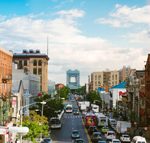 City Council approves East Harlem rezoning
City Council approves East Harlem rezoning
Trending
Mayor’s Mandatory Inclusionary Housing is failing: report
Manhattan Institute says program falls short of predecessor
Stalled rezonings aren’t the only problems plaguing the de Blasio administration’s Mandatory Inclusionary Housing program. According to a new report, MIH is also concentrating affordable housing in low-income areas and is “deeply subsidized.”
The report, by the Manhattan Institute, a conservative think tank, says the 2016 initiative is failing to execute its strategy to provide a zoning bonus that covers the cost of mandated affordable housing.
Read more
 City Council approves East Harlem rezoning
City Council approves East Harlem rezoning
Authored by Eric Kober, who worked for decades at the Department of City Planning including as director of housing, economic and infrastructure planning, the report compares the results of MIH to its predecessor, voluntary inclusionary housing (a program launched in the late 1980s).
Kober’s analysis of city data from January 2014 through September 2019 found that 8,476 affordable units were permitted or completed through the voluntary program. From MIH’s launch in March 2016 through September 2019, only 2,065 units have been permitted or completed through the program, which mandates affordable units in residential projects in rezoned areas.
The report claims that a majority of the MIH units are subsidized because the city has targeted markets that don’t support rent levels that make such developments profitable on their own.
“MIH, as adopted, is economically feasible for new rental developments only in strong and very strong housing-market neighborhoods and when the city provides additional subsidies,” the report states.
Department of Housing Preservation and Development Commissioner Louise Carroll called the report “disingenuous,” noting that the full cycle of development — from rezoning to ribbon-cutting — typically takes four and a half years. She also disputed the report’s data, saying the agency has produced 2,641 MIH units in the past three years and approved private applications for 7,000 units.
“The real estate industry and businesses are always pushing against regulation,” she said.
Also, the geographic boundaries of the voluntary and mandatory programs are not identical. De Blasio’s program depends on getting neighborhood and spot rezonings approved by the City Council. MIH does not yet apply in most of the city.
The report also asserts that all inclusionary housing is essentially voluntary because developers simply won’t build if the economics of a project don’t work.
“You can’t just make people do it,” Kober said. “They are not going to do it unless they get the rate of return they need.”
The report recommends rezoning manufacturing districts, including Soho, Midtown South, Noho, East Williamsburg, Long Island City and Gowanus, and restoring an affordability option proposed under an earlier version of MIH that allowed for tenants at higher income levels, dubbed the “workforce option.”
The program has faced further obstacles in recent weeks. In December, a state judge struck down the rezoning in Inwood. Last week, negotiations to rezone Bushwick fell apart after local council members and de Blasio administration couldn’t agree on the scale and affordability levels of the plan.
On Wednesday, City Council member Rafael Salamanca Jr., who represents the South Bronx, wrote in an op-ed that he didn’t support the administration’s proposal for Southern Boulevard — effectively killing it.
“With this upzoning, I fear that the city could trigger a rush of developers looking to purchase land and build thousands of unregulated units along Southern Boulevard, Westchester Avenue and the Bronx River,” he wrote in CityLimits. “While City Planning touts the significance of mandatory inclusionary housing creating permanent affordable housing in rezonings, the truth is that MIH affordability only applies to a small fraction of the new units created, with the rest of the units being market-rate.”
So far, the city has rezoned only six of the 15 areas pegged for MIH.




